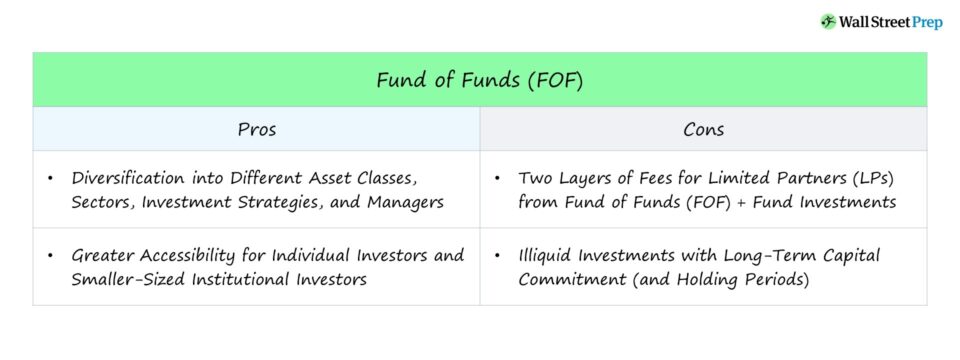What is Fund of Funds?
Fund of Funds (FOF) refers to a pooled investment vehicle in which capital commitments from investors are allocated to a predetermined number of funds with different strategies.

How Does a Fund of Funds Work?
The value proposition of a fund of funds (FOF) to its investors is the ability to take over the responsibility of strategic asset allocation.
Conceptually, the fund-of-funds investment strategy can be thought of as a “portfolio” comprised of multiple different funds.
Most often, fund of funds managers invest in the following firms:
- Private Equity Firms
- Hedge Funds
- Mutual Funds
Since the fund of funds (FOF) is an investor in these actively managed funds – i.e. the FOF is a limited partner (LP) – the fund structure is often referred to as a “multi-manager investment fund.”
Therefore, rather than selecting individual stocks and bonds to invest in, or taking part in riskier strategies like early-stage venture investing, growth equity, or late-stage buyouts – a fund of funds (FOF) performs diligence on active managers to invest.
Most of the diligence conducted by a fund of funds (FOF) focuses on the following areas:
- Fund Selection (Manager)
- Asset Class Allocation
- Sectors and Industry Trends
- Portfolio Weighting
The value-add of these firms is identifying the right funds to allocate capital in order to maximize returns while simultaneously managing the downside risk by spreading their capital across different firms, fund strategies, sectors, and asset classes.
What are the Benefits of Fund of Funds Investing?
The value proposition to investors is the benefit of diversification, i.e. the risk of the portfolio itself is reduced by holding investments across a broad set of asset classes and/or investment strategies.
Since a fund of funds (FOF) invests in active managers, the limited partners (LPs) of a fund of funds receive indirect exposure to not only one (or two) but numerous active managers.
The next benefit is the lower minimum qualification requirements to be a limited partner (LP), making FOFs more accessible to a broader range of investors.
In particular, top-performing funds will often decline LP inquiries that are too small in investment size because of the sheer abundance of demand, so a FOF (and their pooled capital) can be one method to bypass the minimum threshold to “get in on” the fund.
In effect, individual investors and smaller-sized institutional investors who might not meet the criteria to be an LP in certain funds can be effectively “grouped together” via the FOF to gain access.
The performance information of managers – especially for private equity and hedge funds – lacks transparency, as the data is typically considered non-public confidential information, barring some exceptions.
What is the Fee Structure in the Fund of Funds Strategy?
A fund of funds (FOF) is led by experienced investment professionals well-versed in portfolio management with broad knowledge of different asset classes, sectors, and connections to fund managers.
One area of criticism of the fund of funds business model is the fee structure, which is ordinarily higher than that of mutual funds because of the management fees.
FOFs offer convenience to their investors – i.e. the LPs do not themselves have to structure their portfolio to diversify their investments to achieve an optimal risk/return profile – but there is criticism around whether the FOF’s contributions justify their fees.
Since capital is invested into active managers, there are now two layers of fees, as most if not all active managers charge fees themselves.
- Fees of Underlying Fund Investments
- Fund of Funds Fees
The fund of funds investment strategy is increasingly under pressure as of late to reduce its fee structure because of the underperformance of active managers.
FOF managers charge a 0.5% to 1.0% annual management fee, with some taking a minor portion of the carried interest (“carry”) in the 5.0% to 10.0% range.
- FOF Management Fee = 0.5% to 1.0%
- FOF Carried Interest = 5.0% to 10.0%
The fund of funds fees are placed on top of the fees charged by the underlying active fund managers that typically charge fees in the following ranges.
- Fund Management Fee = 1.5% to 2.5%
- Fund Carried Interest = 15.0% to 25.0%
The double-fee structure can further reduce the net returns to the limited partners (LPs) of the FOF when active management is under constant scrutiny because of sub-par returns.






